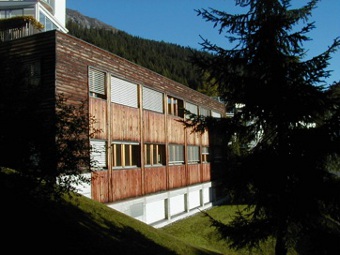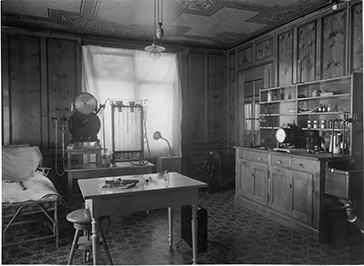About
The Swiss Institute of Allergy and Asthma Research (SIAF) is a department of the foundation Swiss Research Institutes for High Altitude Climate and Medicine Davos (SFI) and an affiliated institute of the University of Zurich and member of the Life Science Zurich Graduate School. The institute in its current form arised from the medical department of SFI in 1988. Since this time the research activities at SIAF are focused on basic research in the field of allergies and asthma.
| 1905 | Tuberculosis Research Institute Davos Medical Society Davos, Community of Davos, K. Turban |
| 1907 | Physical-Meteorological Observatory Davos, C. Dorno |
| 1922 | Swiss Research Institute for High Altitude Climate and Tuberculosis |
| 1922-1933 | A. Loewy, High Altitude Physiology |
| 1934-1937 | F. Roulet, Chemistry of Mycobacterium Tuberculosis |
| 1938-1954 | W. Berblinger, Pathology of Tuberculosis |
| 1954-1960 | W. A. Vischer, Resistance to Mycobacterium Tuberculosis |
| 1961 | Swiss Research Institute for High Altitude Climate and Medicine |
| 1961-1985 | E. Sorkin, Neuroendocrine-Immune Interactions |
| 1985-1987 | H. Basedowsky, Neuroendocrine-Immune Interactions |
| 1988 | Swiss Insitute of Allergy and Asthma Research (SIAF) |
| 1988-2006 | K. Blaser, Mechanisms of Allergy and Asthma |
| 2006- | C. A. Akdis, Mechanisms and Novel Methods for the Diagnosis and Treatment of Allergy and Asthma |


Allergies are among the major health challenges of modern industrial societies with the growing frequencies of 10-30% in the population. Asthma, atopic dermatitis, allergic rhinitis, chronic rhinosinusitis, food allergy and anaphylaxis provide a significant socio-economic burden on the economy. Over the last decades, the prevalence of allergic diseases has increased all over the world. The reasons are still not fully clear, although it appears that certain factors of modern life-style and protection against common infections and bacterial products during early childhood are responsible for the enormous increase. Today, allergic diseases are affecting the lives of more than one billion people worldwide, and their prevalence is expected to reach up to 4 billion in 2050. The prevalence of allergic diseases and socioeconomic impact are particularly on the rise in urbanizing regions and globalizing world in association with environmental and lifestyle changes. Apart from individual suffering of patients, allergic diseases present a very high socio-economic burden to health care systems and families. In addition, patient care and access to diagnosis and treatment is inadequate in many developing regions and countries. Effective policies and strategy development are needed to fill this gap at the global, regional and national level.
The story of the Swiss Institute of Allergy and Asthma Research (SIAF) started in 1905 as the Tuberculosis Research Institute Davos and was founded on the request of Professor Karl Turban, the Davos Doctors’ Association and the municipality of Davos. The Swiss Institute of Allergy and Asthma Research (SIAF) was developed as a department of the foundation Swiss Research Institutes for High Altitude Climate and Medicine Davos (SFI) in 1988. SIAF is an affiliated institute of the University of Zurich since 1995 and member of the Life Science Zurich Graduate School since 2008, a joint post graduate education program of the Swiss Federal Institute of Technology and the University of Zurich.
The research at SIAF is focused on a patient-relevant translational research and investigation of immunological principles of allergic diseases and asthma to find new preventive and curative treatments for the benefit of the patients and their families. SIAF is also focusing on the personalized medicine to develop treatment approaches that are better tailored to the needs of individual patients. Major research aims are to develop curative treatment and prevention of allergies and asthma with a focus on immune tolerance to allergens, epithelial barrier, allergen-specific immunotherapy, rapid diagnosis and microbiota. Human research has been pursued at the front level with a main emphasis given on patient-relevant research.
Even as an institute with relatively small resources, compared to some well-known and highly acknowledged institutions and universities, the SIAF can compete in number of publications. The more are the selection of projects, their originality and news content important for the institute’s success. The SIAF has contributed with original work and key findings in all fields of allergology and in some cases has changed the view of current understanding of the mechanisms leading to allergic inflammations. Accordingly, most publications are often cited and in terms of citations per publication the SIAF ranges among the world leading institutes in clinical research, as taken from the ISI Web of Science. Currently, the SIAF has about 45 co-workers, mostly biologists, biochemists and physicians. So far, more than 1‘000 publications in peerreviewed journals and about 564 other scientific articles or book contributions have been published. According to the ISI-Web of Citations, the SIAF keeps one of the highest ranks worldwide with more than 44 citations per publication in clinical research and a total of approx. 40’000 citations. The group leaders of SIAF are opinion leaders, who take place in editorial boards of major allergy, immunology and asthma journals and are regularly invited to the leading international congresses in the field.
For further information about the current research activities of SIAF members see our SIAF Annual Report 2017.
